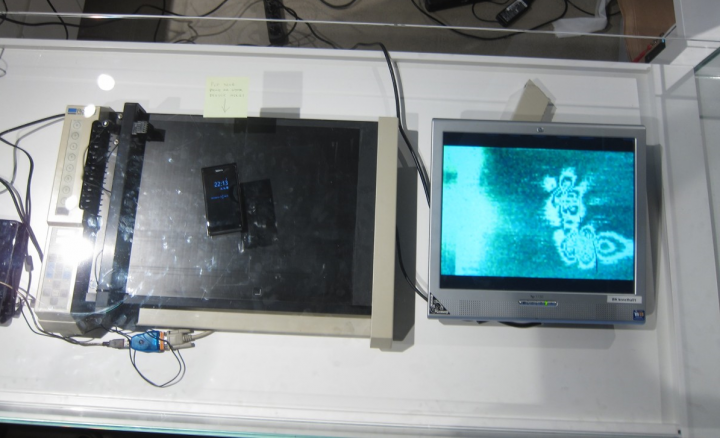Ljudmilas artist in residency exhibition 2013: Bengt Sjölén: TEMPEST aura

Opening: Wednesday, October 2nd, 7pm
Location: Aksioma | Project Space, Resljeva 7 (entrance: Komenskega 18), Ljubljana
Coproduction: Aksioma - Institute for Contemporary Arts
2nd – 18th October 2013
TEMPEST aura
Bengt Sjölén, a resident artist at Ljudmila, Art and Science Laboratory, in September 2013, has developed a device for visualising the emissions of any electronic gadget. For art hack day at Bonniers Konsthall, where he constructed the first prototype, he described the principle of the TEMPEST aura as follows: “A device for mapping the electromagnetic emanations of any electronic device. Any transition of an electric signal between on and off, between current and no current, will also transmit a burst of electromagnetic energy that can be intercepted by a receiver and in this way all of our information processing devices also leak the information they process for anyone to eavesdrop. TEMPEST aura takes images, much like a scanner, of an electronic device you put on its [glass] surface, showing the aura of information and energy emanating from the device.”

The device is the second in the series of explorations of technology that Sjölén has developed for TEMPEST, a codename referring to the investigation and study of compromising emanations (CE). The technology was developed for sophisticated eavesdropping which intercepts the signals of unintentional emissions. TEMPEST radio, the first such device by the artist, is also exhibited in the gallery space; it translates these unintentional transmissions from our devices into sound.
It is perhaps important to note that this project is not solely an illustration of a concept, but an actual technology that the general public is largely unaware of, although it could be widely used for retrieving any data that we produce on our electronic devices, regardless of whether we send the information out or not. TEMPEST aura literally visualises the "ghosts" of electronic machines using an obsolete Roland scanner from 1993 and a copper coil for reading the electromagnetic field and retrieving the data. Simple detectors of this kind make the relative accessibility of such actions quite evident. The artist described the process of converting and visualising the data: “The picture presented on a separate monitor is a direct translation of the intensities over the measured frequency range mapped to the colour spectrum, just as our eyes and visual cortex map the intensities over the frequencies of visible light to the colours we perceive, so TEMPEST aura strives to represent the data as if our eyes could see the frequency range just as they do visible light.“ Despite the highly suggestive and aesthetic, almost mystical visual outcome, the artist has not manipulated the picture, hence nothing in this representation is arbitrary; he merely faithfully translated electromagnetic smog in terms of algorithmic accuracy. The extremely optimistic adage "everything is connected to everything else" takes a sinister turn when we think about the perforations of the media extensions that link us with the world not only through controlled and voluntary connections, but also through unlikely channels which we might never want to connect through.
So if we are able to measure and visually and sonically represent the electromagnetic field, how deeply can we interrupt the data stream carried by the wave? While the emanated data retrieved by the eavesdropper may reveal information with extreme precision, TEMPEST aura's visualisations suggest a much wider scope of interpretation. For one, the images we recognise in the pictures (e.g. voodoo rattle skull, a face, a landscape, etc.) function as a psychological Rorschach test in which we project our own mental image onto the picture. Any representation triggers the production of meaning in our minds. Electromagnetic leakage from a device thus occurs simultaneously to the unintentional revelation of our deepest mental images.
The question posed by TEMPEST aura goes deep into the relationship we hold with our mechanical extensions. Have the machines that we carry around become disposable apparatus, or have they become an intrinsic part of our bodies? Does the right over one's own body and bodily integrity also apply to the nondisclosure of information on our devices? Does the inviolability of the human body extend to the right of intimate use of our devices (tablets, cell-phones, computers)? The integrity of our personal machines is as important as control over our genetic material, only it enters our body not from within, but from without. The conclusiveness of the human body has long been challenged. The idea of the human body has developed through the ages and is understood not merely as a biological fact, but much more as a cultural notion. TEMPEST aura triggers the effects of external objects on the human mind and the production of meaning. Conversely, the effects of the mind on physical reality have long been explored by mystical practices, and Karl Popper later subjected them to scientific research. The effect of the mind on physical reality gained momentum in contemporary research on neurotransmitters and hormones and their influence on the immediate world around us.* Thus the human body is an extensive field rather than a sphere of subjective representations of self and function that differs from culture to culture. Along with its apparatus, the body has the function of speaking for itself. The extensive biological body and machines are integrated and merged together at the thin, undefined border of corporeality. One may consider the other invasive, but thus far there has been no scientific proof that one (the electromagnetic fields used in the project and elsewhere) is harmful to the other, thus making for a rather particular symbiosis.
Communication technologies held a promise of promoting free mobility and free access to information. Understood as essential extensions of our body, our apparatus become a constitutive part of our integrity. Given that we hold anarchistic ideas of self-ownership, which is in opposition to the neoliberal notion of the individual obscured by the notion of private property, we may take as our ideal the growth of new hybrid identities; not for the sake of owning or acquiring material extensions, but rather to allow these extensions to enhance our mental selves. Once the host body adopts it, the machine should not be controlled by the state or the corporation which produced it.
Text by Ida Hiršenfelder
(*) It is perhaps worth noting that Bengt Sjölén is also deeply interested in molecular biology and biochemistry. He is an active member of Hacteria – participating at workshops like NanoŠmano (2012) in Ljubljana organized by Biotechna and hacteria.org.
About the artist
Bengt Sjölén is an independent software and hardware designer, hacker and artist based in Stockholm and Berlin, and with roots in the home computer demo scene. He is not part of one single group but rather collaborates within multiple networks like Weise7 in Berlin, Teenage Engineering in Stockholm and aether architecture in Budapest. Current and continuous experimentation spans programmatic generation of design, function, hardware and code, electromagnetic investigations, networking technologies, reverse engineering, molecular life sciences, architecture, visualizations and visuals, sound and self modifying code. His work has been exhibited internationally at many museums, festivals and exhibitions including Synthetic Times Exhibition (Beijing), NTT ICC (Tokyo), Biennale of Architecture (Venice), ISEA (San Jose, US and Helsinki), Kulturhuset (Stockholm), Pixelache (Helsinki), Ars Electronica (Linz), World Expo 2010(Shanghai), Transmediale (Berlin), Ludwig Muzeum (Budapest) and arte.mov (Sao Paulo and Belo Horizonte, Brazil).
Production: Ljudmila, Art and Science Laboratory, 2013
Coproduction: Aksioma – Institute for Contemporary Arts, Ljubljana
Acknowledgements: Luka Frelih, Ida Hiršenfelder, Andraž Tarman, Steklarstvo Omahen, Marc Dusseiller, Janez Janša, Marcela Okretič, Sonja Grdina, Michael C. Jumič and Tina Dolinšek.
Program Ljudmila is supported by Municipality of Ljubljana, Department for Culture // Aksioma program is supported by Ministry of Culture and Municipality of Ljubljana, Department for Culture
